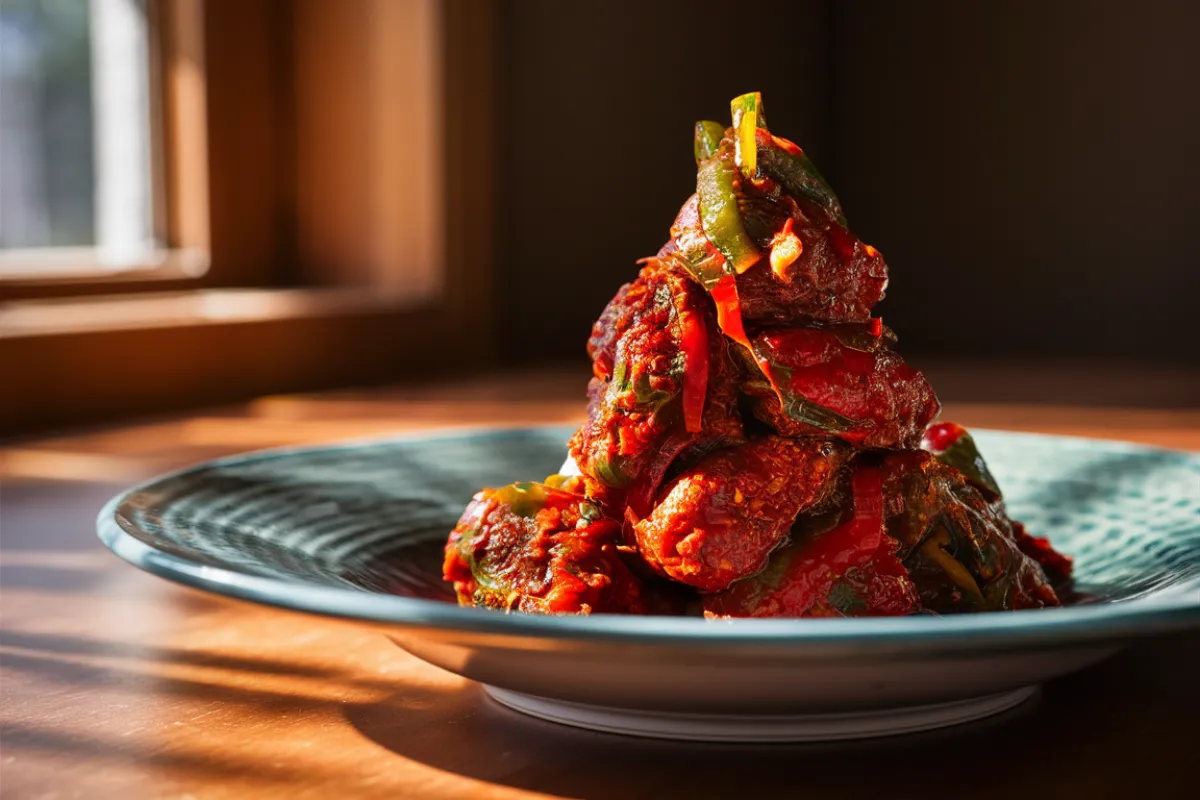Skhug, also known as zhug or s’chug, is a fiery Middle Eastern chili paste that has captivated the taste buds of food enthusiasts around the world. With its origins rooted in Yemeni cuisine, Skhug has become a popular condiment for those who crave an intense, fresh, and herbaceous flavor. The question many people have is, “What does Skhug actually taste like?” Let’s dive into its unique flavor, its history, and how it can elevate a variety of dishes.
History and Origin of Skhug: Where Does Skhug Come From?
Skhug has a rich history that dates back centuries. It originated in Yemen, where it is a staple condiment in many households. Yemeni Jews introduced this hot sauce to Israel, and since then, it has become a significant part of Israeli cuisine. Over time, the sauce spread throughout the Middle East and is now enjoyed worldwide. So, what does Skhug taste like?
The word “Skhug” comes from the Arabic word “سحوق” (saḥūq), which means “ground.” This name reflects the traditional preparation method, where all the ingredients are ground together. Although Skhug started in Yemen, it is now common in various Middle Eastern countries. Each region offers a unique twist on the classic recipe. To learn more about the origins and journey of this versatile sauce, check out the Skhug Sauce Guide.
Ingredients and Variations: What Gives Skhug Its Unique Taste?

At its core, Skhug is made from a few fresh, flavorful ingredients. The main components usually include:
- Green or Red Chilies: Fresh chilies are the source of Skhug’s spiciness. Green chilies give a herbal and slightly milder taste, while red chilies add a deeper, sometimes sweeter heat.
- Fresh Garlic: Garlic adds a sharp flavor that balances the heat of the chilies.
- Cilantro: This herb provides a fresh, bright flavor that complements the spicy kick.
- Spices: Cumin, coriander, and cardamom add warmth and complexity.
- Acidity: Lemon juice or vinegar brings a tangy brightness, balancing the heat and herbal notes.
- Olive Oil: Smooths the texture and helps blend all the flavors.
There are two main types of Skhug: green Skhug and red Skhug. Green Skhug, made with green chilies, has a fresh, grassy flavor with a bold herbal punch. Red Skhug, made with red chilies, is slightly sweeter and has a more intense heat. You can find more details on the ingredients and their proportions in the Skhug Sauce Ingredients guide.
Skhug Flavor Profile: What Does Skhug Taste Like?
Skhug has a dynamic blend of flavors. Here’s what you might taste:
- Heat: The first flavor is the intense heat from the chilies. The spiciness can vary depending on the chilies used, but it usually provides a strong, immediate kick.
- Herbal and Fresh: Cilantro and garlic give Skhug its distinct herbal taste. Cilantro offers a bright, zesty flavor, while garlic adds a sharp undertone.
- Citrusy Tang: Lemon juice or vinegar cuts through the heat, adding a refreshing tang.
- Earthy Warmth: Spices like cumin, coriander, and cardamom add a warm, earthy quality.
- Slight Sweetness: Red Skhug often has a subtle sweetness, enhancing the flavor with another layer.
For a deeper understanding of different types of hot sauces and how they compare, check out this guide to different types of hot sauces.
Culinary Uses of Skhug
Skhug is a versatile condiment that enhances many dishes, from traditional Middle Eastern recipes to creative modern pairings. Here are some popular ways to use it:
- As a Condiment for Middle Eastern Dishes: Traditionally served with shawarma, falafel, and hummus. Skhug’s spicy, fresh taste complements these foods.
- With Grilled Meats and Vegetables: Use Skhug with grilled meats like lamb, chicken, or beef. It also adds a kick to grilled vegetables.
- In Sandwiches and Wraps: Spread Skhug on sandwiches, wraps, or pitas for a spicy, zesty flavor. It pairs well with roasted vegetables, feta cheese, or grilled chicken.
- As a Marinade or Rub: Skhug is excellent as a marinade for meats, especially chicken or lamb. The lemon juice or vinegar tenderizes the meat, while the spices and chilies add bold flavors.
- Mixed into Dips: Combine Skhug with yogurt, tahini, or mayonnaise to make a creamy dip. This is great for dipping fresh vegetables, chips, or pita bread.
- With Breakfast Foods: Add Skhug to eggs, whether scrambled, fried, or in an omelet. It also works well with avocado toast or in a breakfast burrito.
- As a Pizza or Pasta Sauce: Use Skhug as an alternative to traditional tomato sauce on pizza or mix it into pasta dishes for a spicy, herbaceous flavor.
For more creative ideas on using Skhug in your meals, check out these Rotisserie Chicken Recipes for new ways to enjoy familiar ingredients.
How Does Skhug Compare to Other Sauces?

Skhug is often compared to other spicy sauces, but it has a unique flavor that sets it apart. Here’s how it compares to some popular alternatives:
- Skhug vs. Harissa: Harissa is a North African chili paste made with roasted red peppers, garlic, and spices. While both are spicy, Harissa has a smokier, sweeter flavor due to the roasted peppers. Skhug is fresher and more herbal, thanks to the cilantro and fresh chilies.
- Skhug vs. Sriracha: Sriracha is a Thai chili sauce with a tangy, slightly sweet flavor. Unlike Sriracha, which contains fermented chilies, vinegar, and sugar, Skhug has no sugar and uses fresh ingredients like cilantro and lemon juice. This gives it a more vibrant, zesty taste.
- Skhug vs. Chimichurri: Chimichurri is an Argentinian sauce made from parsley, garlic, vinegar, and olive oil. Both have fresh, herbaceous qualities, but Skhug is spicier due to the chilies. Chimichurri is milder and more vinegary.
These comparisons highlight Skhug’s unique qualities and why it’s loved by those who enjoy bold, fresh, and spicy flavors. To understand how Skhug fits into the broader category of sauces, the Ultimate Guide to Halibut Recipes provides insights into pairing sauces with seafood and other dishes.
How to Use Skhug: Best Dishes to Pair with Skhug
Making Skhug at home is easy, and you can customize it to your taste. Here’s a basic recipe to get started:
- Ingredients:
- 10-12 fresh green or red chilies (adjust for heat preference)
- 4-5 cloves of garlic
- 1 bunch of cilantro
- 1 teaspoon cumin
- 1 teaspoon coriander
- 1/2 teaspoon cardamom
- Juice of 1 lemon or 2 tablespoons of vinegar
- Salt to taste
- Olive oil to blend
- Instructions:
- Remove the stems from the chilies. For less heat, remove the seeds.
- Place chilies, garlic, and cilantro in a food processor.
- Add cumin, coriander, cardamom, and a pinch of salt.
- Pour in the lemon juice or vinegar and blend, drizzling in olive oil until a coarse paste forms.
- Taste and adjust seasoning as needed. If too spicy, add more lemon juice or vinegar.
- Store the Skhug in a jar in the refrigerator for up to two weeks.
Feel free to experiment with different chilies or add herbs like parsley to create your own version. This homemade Skhug can enhance various dishes with its unique flavor.
Pairing Skhug with Other Foods
Skhug’s versatility makes it an ideal pairing with many foods. Here are some ideas:
- Skhug and Grains: Mix Skhug into rice, quinoa, or couscous for added flavor. It also works well in grain salads.
- Skhug with Seafood: The zesty notes of Skhug complement seafood dishes like grilled shrimp, salmon, or white fish. Use it as a finishing sauce or marinade.
- Skhug on Pizza: Drizzle Skhug over pizza before or after baking. It pairs well with toppings like olives, feta cheese, and roasted vegetables.
- Skhug with Cheese: The heat of Skhug contrasts beautifully with creamy cheeses like goat cheese, feta, or labneh. Use it on cheese boards or swirl it into soft cheeses for a dip.
- Skhug in Salads: Add Skhug to salad dressings for extra flavor. It works well in salads with fresh vegetables, grains, or legumes.
These pairings show how Skhug can elevate even simple dishes. For more ways to enhance your meals, explore these Taco Pasta Recipes that use bold flavors and unique ingredients.
Exploring Regional Variations: What Different Types of Skhug Taste Like

While Skhug’s basic ingredients remain the same, there are many regional variations across the Middle East. Each offers a different twist on the traditional recipe:
- Yemeni Skhug: The original version is very spicy, focusing on green chilies, garlic, cilantro, and a rich blend of spices.
- Israeli Skhug: Found in both green and red versions, it may include extra spices or herbs like parsley and often has a thicker consistency.
- Egyptian and Jordanian Variations: These versions might use more vinegar or lemon juice, giving a sharper tang and sometimes different spices.
Each variation adds to Skhug’s versatility and appeal. You can try these variations by adjusting the ingredients or preparation methods to find your preferred style.
Frequently Asked Questions
- What does Skhug taste like?
Skhug has a spicy, herbal flavor with a fresh, zesty kick. It combines the heat of chilies with the bright, citrusy notes of lemon juice or vinegar, and a warm, earthy blend of spices like cumin, coriander, and cardamom. The taste can vary slightly depending on whether it’s green Skhug (more herbal and grassy) or red Skhug (slightly sweeter and hotter). - Is Skhug very spicy?
Yes, Skhug can be quite spicy, especially if made with hot green or red chilies. However, the heat level can be adjusted by using milder peppers or reducing the number of chilies. You can also balance the spiciness with more lemon juice, vinegar, or a bit of yogurt. - What dishes go well with Skhug?
Skhug pairs well with a variety of dishes like shawarma, falafel, hummus, grilled meats, sandwiches, and even breakfast foods like eggs. It’s also great as a marinade, a dip, or a spicy spread on bread or pizza. - How do you store Skhug?
Skhug should be stored in an airtight container in the refrigerator. It will stay fresh for up to two weeks. For longer storage, you can freeze it in small portions to maintain its flavor and freshness. - Can I make Skhug less spicy?
Absolutely! To make Skhug less spicy, use fewer chilies or choose milder varieties. Removing the seeds and membranes from the chilies can also help reduce the heat. Adding more lemon juice or a bit of sugar can balance the spiciness.
Conclusion: Why Skhug’s Flavor Should Be in Your Kitchen
Skhug is more than a condiment; it’s an experience that combines the heat of fresh chilies, the brightness of herbs, the depth of spices, and the tang of citrus. So, what does Skhug taste like? It delivers a unique blend of spicy, herbal, and tangy flavors that can elevate any dish. Whether you’re new to Middle Eastern cuisine or a seasoned enthusiast, Skhug adds excitement to any meal.
From its rich history to its varied uses, Skhug is more than just a spicy sauce. It reflects the complexity and diversity of Middle Eastern flavors, bringing people together over a love for bold, vibrant food.
Next time you want to spice up your meal, try Skhug. With its unique ingredients and flavors, it’s sure to become a staple in your kitchen. Explore more about how Skhug can transform your dishes by visiting the Skhug Sauce Guide and start experimenting today!

